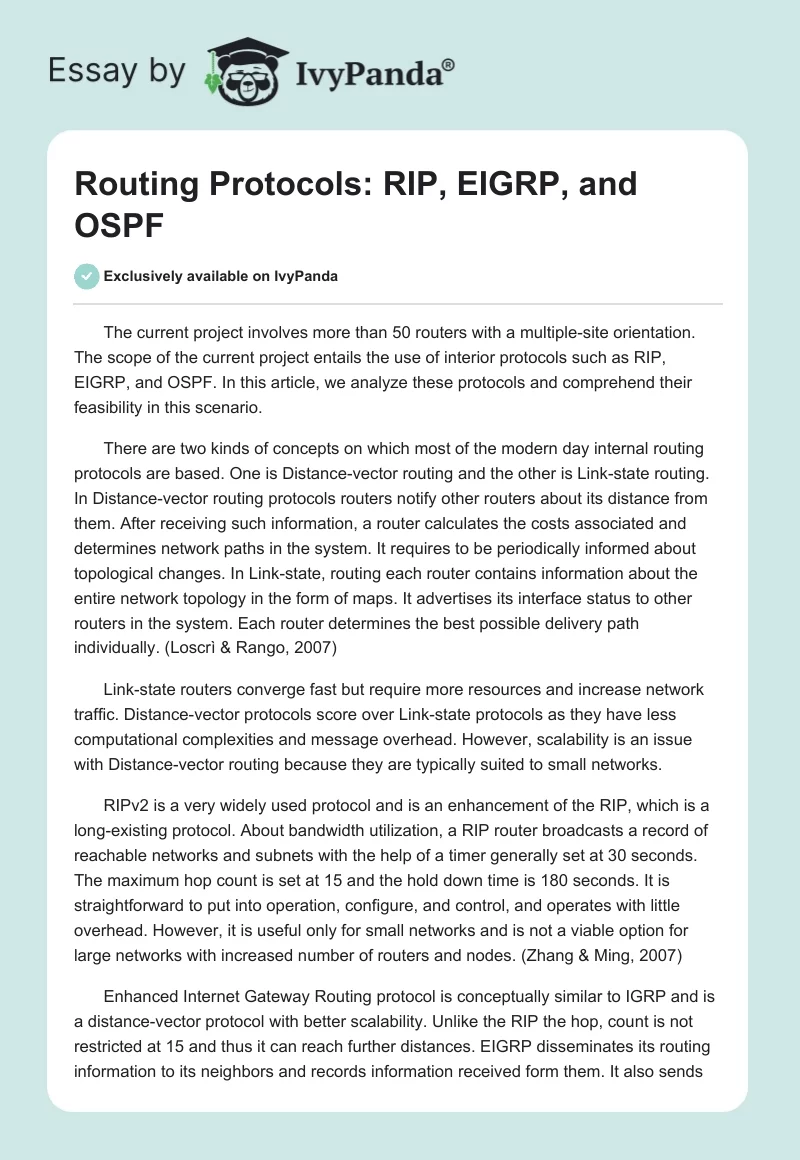The current project involves more than 50 routers with a multiple-site orientation. The scope of the current project entails the use of interior protocols such as RIP, EIGRP, and OSPF. In this article, we analyze these protocols and comprehend their feasibility in this scenario. There are two kinds of concepts on which most of the modern day internal routing protocols are based.
One is Distance-vector routing and the other is Link-state routing. In Distance-vector routing protocols routers notify other routers about its distance from them. After receiving such information, a router calculates the costs associated and determines network paths in the system. It requires to be periodically informed about topological changes. In Link-state, routing each router contains information about the entire network topology in the form of maps. It advertises its interface status to other routers in the system. Each router determines the best possible delivery path individually. (Loscrì & Rango, 2007)
Link-state routers converge fast but require more resources and increase network traffic. Distance-vector protocols score over Link-state protocols as they have less computational complexities and message overhead. However, scalability is an issue with Distance-vector routing because they are typically suited to small networks.
RIPv2 is a very widely used protocol and is an enhancement of the RIP, which is a long-existing protocol. About bandwidth utilization, a RIP router broadcasts a record of reachable networks and subnets with the help of a timer generally set at 30 seconds. The maximum hop count is set at 15 and the hold down time is 180 seconds. It is straightforward to put into operation, configure, and control, and operates with little overhead. However, it is useful only for small networks and is not a viable option for large networks with increased number of routers and nodes. (Zhang & Ming, 2007)
Enhanced Internet Gateway Routing protocol is conceptually similar to IGRP and is a distance-vector protocol with better scalability. Unlike the RIP the hop, count is not restricted at 15 and thus it can reach further distances. EIGRP disseminates its routing information to its neighbors and records information received form them. It also sends hello packets to update other routers on the network about new routers being added. It minimizes routing instability, makes use of bandwidth efficiently in kilobits per second and converges quickly. However, it is a Cisco proprietary and works best with Cisco products only. (Loscrì & Rango, 2007)
OSPF calculates paths routes packets derived from the target IP address found in IP packets. It facilitates variable-length subnet masking, and can identify alterations in the network topology very fast and converges to a loop-free routing configuration in a matter of seconds. Individual elements of the database are updated at a 30-minute time interval, when there are no topological changes. The link-bandwidth increases with the increase in the database size. This consumes a huge amount of router memory.
With OSPF, scalability becomes a major issue. The presence of more than 50 routers would result in slower convergence time, memory shortages and processor overloading. Hence, it may be said that it is an excellent protocol to be used for medium sized networks. (Zhang & Ming, 2007) After evaluating the above protocols, in light of the project requirements, EIGRP is the recommended protocol.
Although RIP and OSPF both offer their own advantages and are very efficient in their own sense they face major issues when applied to large networks. Further, EIGRP offer various advantages such as low bandwidth usage and instability minimizing capability. Hence, EIGRP is the most efficient protocol that can be applied to this network containing more than 50 routers connecting multiple sites.
References
Loscrì, V., Rango, F. (2007). Mobile Networks Ad hoc on demand multipath distance vector routing (AOMDV) over a distributed TDMA MAC protocol for QoS support in wireless ad hoc networks: integration issues and performance evaluation. European Transactions on Telecommunications. 18(2), 141-156
Zhang, C., Ming, Y. (2007). Ad hoc network routing and security: A review. International Journal of Communication Systems. 20(8), 909-925.


